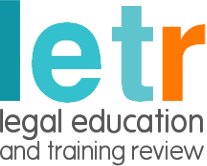A way ahead – a needs-led approach?
4.57 LSET does not exist in a vacuum, it serves a purpose. As regards professional education and training, that purpose is, primarily, to ensure a standard of work performance that will assure consumers that those they employ are competent and professional in their approach. This is reflected in the focus of the LSA 2007 regulatory objectives, not just on the public and consumer interest, but in the professional commitments to the rule of law, access to justice and the professional principles.
4.58 It is proposed that these priorities point to what might be called a ‘needs-led’ approach to competency or OBET (see Gruppen et al, 2010; cf Redmond and Roper, 2001:67-8), in which social needs, not the curriculum, determine the outcomes of learning (Figure 4.1). Such an approach treats preparing trainees for effective practice in the public interest as the primary function of professional education. The strong focus on social needs/interests distinguishes it from public or liberal higher education which may properly place a greater emphasis on the acquisition of knowledge for its own sake, and on the personal interests and development of the learner, over and above the social and economic benefits that accrue from such education.[1]
Figure 4.1: OBET as a needs-led approach
4.59 In terms of process, a needs-led approach suggests that the starting point must be to define initial ‘day one’ competence. It is this that provides ‘the minimum level of competence the public is entitled to expect from a person licensed to carry out professional activities’ (LSI, 2012:3). A set of ‘day one outcomes’, specifying the standard required at the point of qualification for a title or activity, could provide both an appropriate threshold and a basis for reverse engineering outcomes for earlier stages of training.[2] ‘Day One outcomes’ have been produced as part of the Law Society’s Training Framework Review. These were commended and used by Stuckey et al (2007:53-5) in developing outcome statements as part of the US Best Practices project, and, in a revised form, they now provide the basis for assessment in the SRA’sQLTS.[3] These provide a useful example but were derived by consultation rather than occupational analysis or empirical evaluation, and are drawn more widely than the more flexible, pluralistic, approach advocated by this report. A move to risk-based regulation would warrant some greater degree of empirical validation, with more research on the actual work of the legal services providers concerned. [4]
[1] This is reflected in the distinction this report has consistently sought to make between LSET and public legal education, or liberal higher legal education.
[2] Eg, in an assessment-only scheme, like the QLTS. Note however that there was only limited support for the idea that an assessment-only scheme should become the norm for entry to legal practice.
[3] A similar set of day one competencies now appears in the CILEx Competency Framework to be used from June 2013 to determine Chartered status, and as a result of the Wood Review, a competency framework now exists for pupillage.
[4] Cf the Solicitors and their Skills work carried out for the LETR research phase, reported in Chapter 2. Also the exercise undertaken in evaluating the Canadian national standards: see Federation of Law Societies of Canada (2012c). This involved testing the range of standards with a large, statistically reliable, cross-section of the profession, though it should be noted that, by itself, this does not capture consumer perceptions of risk.


